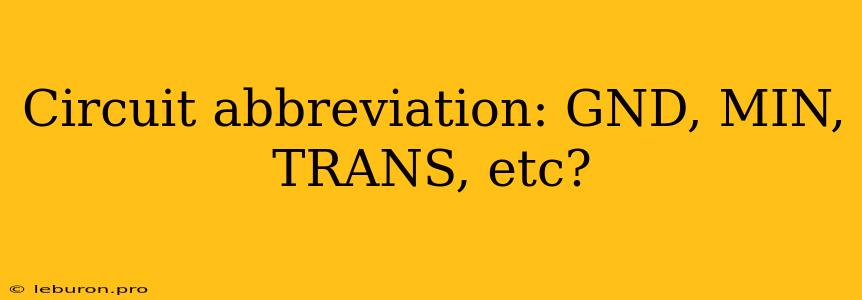In the realm of electronics and circuit design, understanding the language of abbreviations is essential for effective communication and comprehension. These abbreviations serve as shorthand for common elements, concepts, and parameters, streamlining circuit diagrams and technical documentation. Among these abbreviations, those related to circuit components and their properties hold particular significance. This article delves into the meanings and applications of some commonly encountered circuit abbreviations, focusing on GND, MIN, and TRANS, shedding light on their roles in circuit analysis and design.
Understanding Circuit Abbreviations
Circuit abbreviations are a standardized form of communication within the electrical engineering community. They serve to simplify complex concepts, reducing the need for lengthy descriptions and enhancing clarity. Each abbreviation represents a specific term or element, facilitating quicker comprehension and promoting efficient collaboration.
GND: The Ground Reference
GND, an abbreviation ubiquitous in circuit diagrams, stands for Ground. Ground, in the context of circuits, represents the reference point for all voltage measurements. It is often considered the zero-volt potential, providing a common reference for all other points within the circuit.
The Significance of Ground:
- Voltage Reference: Ground defines the zero-volt level, allowing for the measurement of voltage differences across components relative to this reference.
- Current Return Path: In most circuits, ground serves as the return path for current, completing the electrical circuit.
- Safety Ground: In some cases, ground can be connected to the earth, providing a safety measure by grounding electrical devices and preventing the build-up of dangerous static charges.
Types of Ground:
- Real Ground: Connected to the actual earth through grounding rods or other grounding systems.
- Virtual Ground: A point in a circuit designated as ground even though it is not directly connected to the earth.
- Chassis Ground: A point on the metal frame or chassis of a device that is designated as ground.
Key Points:
- Symbol: Ground is typically represented by a triangle symbol with a horizontal line at its base.
- Multiple Grounds: Circuits can have multiple ground connections, depending on the complexity and design.
- Safety and Functionality: Understanding the role of ground is crucial for safe and functional circuit operation.
MIN: Minimum Value
MIN is an abbreviation used to represent the minimum value of a parameter or specification. In circuit design, it is often used in conjunction with maximum (MAX) values to define the operating range for components or systems.
Applications of MIN:
- Voltage Ratings: MIN voltage rating indicates the minimum voltage a component can withstand without damage.
- Current Ratings: MIN current rating indicates the minimum current a component can safely handle.
- Operating Temperature: MIN operating temperature indicates the lowest temperature at which a component can operate reliably.
Importance of MIN Values:
- Component Selection: Understanding MIN values ensures the selection of appropriate components that can withstand the intended operating conditions.
- Design Constraints: MIN values impose constraints on the design, ensuring that the circuit can function reliably under all expected conditions.
- Performance Optimization: By considering MIN values, designers can optimize circuit performance by avoiding conditions that could lead to component failure.
Key Points:
- MIN and MAX: MIN is always used in conjunction with MAX to define a range.
- Unit Specificity: MIN values are always specified with appropriate units (e.g., volts, amps, degrees Celsius).
- Design Considerations: MIN values should be carefully considered during all stages of circuit design.
TRANS: Transistor
TRANS is a commonly used abbreviation for Transistor. Transistors are semiconductor devices that act as the foundation of modern electronics, playing a crucial role in amplification, switching, and signal processing.
Types of Transistors:
- Bipolar Junction Transistor (BJT): Consists of three layers of semiconductor material, typically silicon.
- Field-Effect Transistor (FET): Controls the flow of current through a channel using an electric field.
Functionality of Transistors:
- Amplification: Transistors can amplify weak signals, increasing their strength for further processing.
- Switching: Transistors can act as electronic switches, controlling the flow of current based on an input signal.
- Signal Processing: Transistors are essential for various signal processing applications, including filtering, modulation, and demodulation.
Significance of TRANS in Circuits:
- Building Blocks of Electronics: Transistors are the fundamental building blocks for a wide range of electronic devices.
- Circuit Complexity: Transistors enable the creation of complex and sophisticated circuits, driving technological advancements.
- Design Flexibility: Transistors offer significant design flexibility, allowing for the implementation of various circuit functions.
Key Points:
- Symbol: Transistors are represented by different symbols depending on their type (BJT or FET).
- Multiple Transistors: Circuits can contain multiple transistors, each performing a specific function.
- Understanding TRANS Functionality: Understanding the functionality of transistors is essential for circuit design and analysis.
Beyond the Basics
While GND, MIN, and TRANS are fundamental abbreviations, countless others exist within the realm of circuit design. Some common examples include:
- VCC: Power supply voltage (typically positive).
- VEE: Power supply voltage (typically negative).
- R: Resistance.
- C: Capacitance.
- L: Inductance.
- PWM: Pulse Width Modulation.
- ADC: Analog-to-Digital Converter.
- DAC: Digital-to-Analog Converter.
Mastering these abbreviations is essential for navigating the complex world of circuit design and understanding technical documentation. As you delve deeper into electronics, you will encounter even more specialized abbreviations specific to different circuit families and applications.
The ability to decipher these abbreviations empowers you to effectively communicate with other engineers and professionals within the field, ensuring clarity and precision in your work. This shared language is a fundamental aspect of the world of electronics, enabling the development and advancement of technology.
